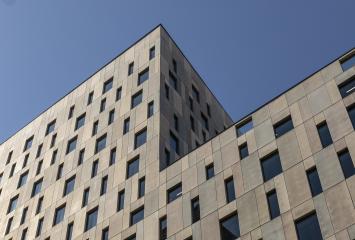Colonial’s Role in Low-Emission Zones
More than three hundred European cities with over 50,000 inhabitants have launched low-emission zone projects in recent years. These are urban areas where, through measures such as restricting highly polluting vehicles and promoting the use of low-emission alternatives, the goal is to meet the air quality limit values set by the European Union. In this new blog article, we will delve into the many benefits of these zones for their occupants and Colonial’s contribution to their success.
Improved Air Quality
One of the main motivations behind the creation of low-emission zones is health. After all, pollutants emitted by traditional vehicles can worsen medical conditions such as asthma, allergies, respiratory issues, or cardiovascular problems. In this regard, all the buildings in our portfolio located within low-emission zones in Madrid or Barcelona feature measures to reduce carbon footprint and purify the air. These include the installation of green areas that capture carbon dioxide and convert it into oxygen.
Less Noise Pollution
In general terms, traditional motor vehicles generate much more noise than their electric or hybrid counterparts. And far from being a minor issue, this directly impacts the quality of life for people living or working in high-traffic areas. In this respect, Colonial also intervenes in our buildings to limit external noise disruptions by using high-quality insulating construction materials. This results in greater concentration for workers operating daily in our office buildings.
Economic Savings
The low-emission zones of the future will not solely focus on promoting specific types of vehicles. These areas are expected to become spaces where all elements contribute to sustainability—including buildings. That’s where energy efficiency comes into play: the use of advanced resource management systems, high-quality thermal insulation, and renewable energy sources are some of the strategies we use at Colonial to achieve it. And this translates into lower electricity bills for those occupying our buildings.
Greater Mobility
One consequence of low-emission zones limiting access to polluting vehicles is the multiplication of alternative mobility options. After all, people still need to get from one place to another. As a result, these zones often offer more options for carsharing, microtransport like electric scooters, and public transport. In our commitment to supporting this diversity of sustainable transport methods, we include microtransport parking and electric charging stations in some of the assets located in these key areas.
More Pleasant Environment
Reduced traffic and lower vehicle speeds make low-emission zones much safer for pedestrians and cyclists. In fact, we’ve already seen how the designation of some of these zones has led to the expansion of walking areas. In other words, low-emission zones can encourage the creation of green spaces and rest areas—a practice we implement at Colonial in our office spaces. These are areas that promote human well-being.

